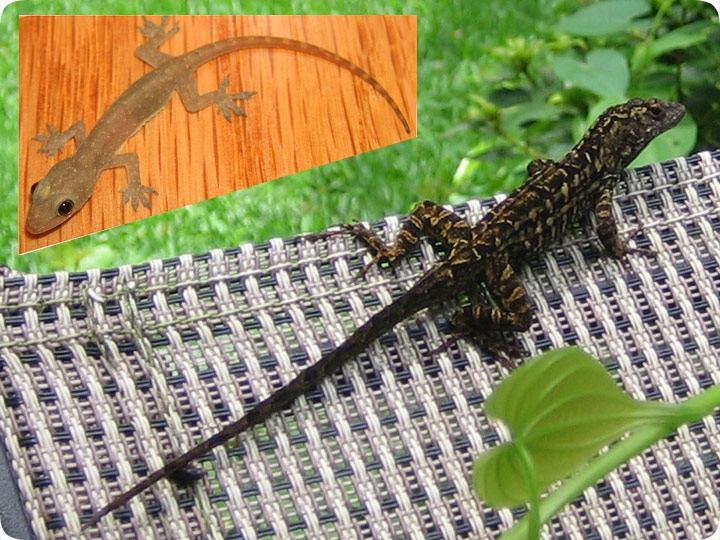-
info@aaanimalcontrol.com
Call us for help in your town
Humane Wildlife Education
Florida Lizards

07.02.2005 - When I was a small child, I loved to collect reptiles and amphibians. The sight of a mere toad filled me with a sort of brilliant and breathless thrill that winning the lottery today would not nearly match. It'd be hard to describe
just how much, at my tender young age, I longed to catch and possess the creepy crawly critters of the world, particularly if they were covered in scales.
So at the age of four years old, my family took a vacation to Disney World Resorts in Orlando. During
that trip, I made all sorts of innocent four-year-old discoveries, such as the day I dug a deep hole on the Seven Seas Lagoon lake, hit the layer of dark Florida mud below the imported beach sand, and ran up the beach screaming wildly about how I'd struck oil.
While my parents love to grin at this story years later, I felt a far greater surge of excitement when, at the base of a tree in EPCOT theme park, I saw a small lizard. I practically had a heart attack. I'd never seen a lizard in the wild before. I'd caught many of the other types of reptiles and
amphibians in my life - frogs, toads, snakes, turtles, salamanders, but an honest-to-goodness lizard, now that was an exotic treasure beyond my wildest dreams. I longed to have that lizard in my hands or a jar or box, to study it, and to just possess it,
more than I can remember wanting anything. I entered full-fledged Hope Mode with a slight sense of panic.
I slowly edged toward the glittering gem before me, innocently perched on the base of the tree, hand ready, prepared to lunge for all I was worth with
the swift grasp that had captured so many crawling creatures before. Then, in a flash, the lizard darted away, into the undergrowth, and it was gone. Just like that. I felt numb, and my heart sunk. I'd lost my chance at a one-in-a-million rare treasure. My
dream had slipped away. For the remainder of the vacation, and for many years after that, I thought about my lost opportunity, the Lizard that Got Away.
Then I moved to Florida as an adult, and found out that the things are more common than cockroaches.
Do it yourself: Visit my How To Get Rid of Lizards page for tips and advice.
Get professional help: Visit my Nationwide Pro Directory of wildlife removal experts.
For more wildlife stories, click my Wildlife Blog
or click my below banner to hire a local trapper.
Because of the weather that Florida supplies year-round, it can be host to many animals seeking the benefits of the area. In Southwest Florida especially, lizards have an easy and thriving lifestyle. There are many different species of lizards in Florida, both native and non-native, with new ones being found even now. Non-native species do pose a threat to the natural landscape, but lizards come in abundance in Florida. Iguanas, as an example, destroy the vegetation in Florida, and can even nest in attic spaces. They pose a real threat to the native populations, including the burrowing owl and the gopher tortoise, and the Tokay gecko as an example can leave a nasty bite during an attack, explaining why they're such a big pest.
Iguanas, Nile monitors, and Tegus are all classed under hazardous and invasive lizard species. They have sharp teeth, strong claws, and powerful tails that are used as effective weaponry. There aren't many venomous lizards within Florida, but some of the nuisance lizards have toxic saliva. This can make you very sick, like the Nile monitor's bite for example, and you should seek medical help immediately once bitten. Some of the smaller lizards, which may seem harmless at first glance, are also hazardous. The Tokay gecko, for example, is very small and cute-looking but can be nasty. They have teeth, and if they bite you, the only way to get it off is to hold it underwater.
The Florida sun means that nuisance lizards can thrive, and they take advantage of the plentiful food sources, hiding in its vegetation with ease. The non-native lizard population thrives in these circumstances. While they may have been limited in their own homelands, for example with the presence of their natural predators, the limitation is removed while they are in Florida, and therefore they wreak havoc on the native species. Wildlife control professionals, although adept at controlling the species, gave up on limiting the spread 100%, because it's becoming impossible.
If you want to get rid of the lizards that may be invading your home, one small and easy tip is that you shouldn't only be removing them as they get into the home, as that's only part of the problem. Try to find out where exactly they are coming from, and block up that area, making your home as unattractive as possible. This limits any further infestation and potentially hatching of many more lizards in the future. Lizards can be a real pest, but if you get your house in order, it can be solved without too much hassle!




















